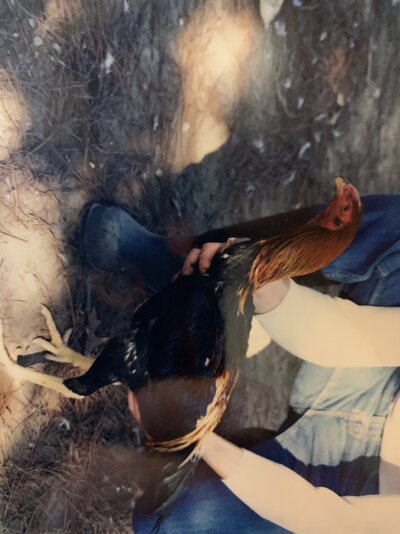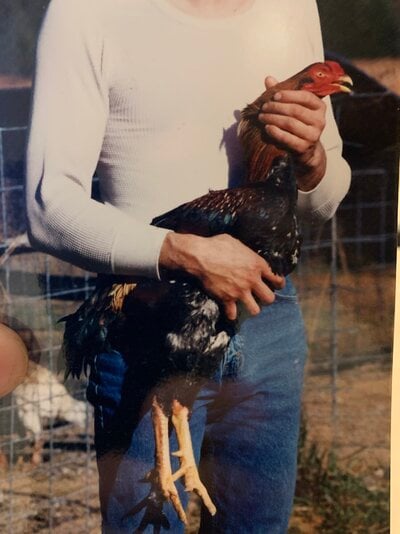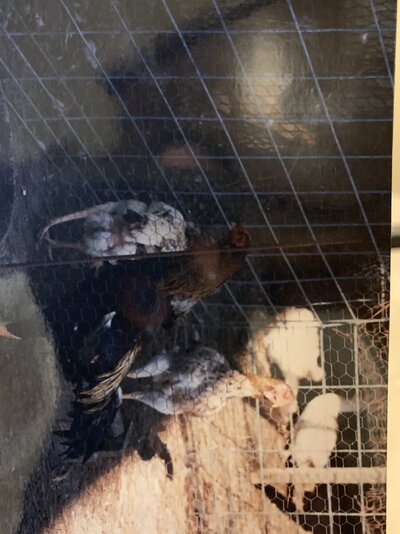Hey all! Here's a new thread for discussing a breed and displaying pictures: the Saipan "Jungle Fowl" thread!!! I don't actually own Saipans myself, but in the meantime, I noticed their wasn't a Saipan thread, so if anyone has any pics or experience with this rare and magnificent breed, please post here!

For those who are not very familiar with the Saipan, it is a very tall bird with a stance and frame that screams game bloodlines. Its legs and neck are exceptionally long, and its tail is rather short, even for a gamebird. Many colors have been created from Saipan bloodlines and called "Saipans", but in my opinion a bird that truly has Saipan blood will have a color pattern similar to BBR but with a golden orange/yellow to replace the red. Saipans are not true Jungle Fowl, which compose a family of about four smallish birds in Southeast Asia, but rather, more accurately, "Plains Fowl". They generally reach a maximum weight of 13 pounds in males and 9 pounds in females.
The Saipanese Chicken (as it should more accurately be dubbed) originated on the island of Saipan in the Pacific, as its name implies. A Mr. B.W. Saylor first brought the breed to the USA in the aftermath of WWII. By then, the pure Saipanese chicken had almost become extinct by mingling with various chicken breeds brought to the island by the Japanese, but Saylor was able to salvage five chicks with pure blood just in time. He theorized that the true Saipan chicken never had a comb (most "Saipans" have a pea comb today), and that offspring with flat or absent combs were closer to the actual Saipan than the pea-combed variety. Saylor also believed that the Saipanese chicken and the Red Jungle Fowl composed two very different families of chickens: Saipans, from whence we get our gamefowl like the Asils and Shamos; and the Junglefowl, from whence we get most of the other breeds. He based this theory on the extreme difficulties he encountered in crossing the Saipan and the Red Junglefowl. If I remember correctly, in the article "The Saipan Jungle Fowl" that he wrote in the 1970s, he said that, out of thirty settings of pure Saipan cross pure Red Junglefowl, he only got one live chick.
I have read elsewhere that pure Saipanese chickens are virtually extinct: excessive inbreeding and various attempts to reproduce the breed have ultimately led to its destruction. Hatcheries would be more honest to say that they sell Saipan crosses instead of pure Saipans; however, some hatcheries might sell the flat-combed variety of the Saipan, implying that they might have purer bloodlines than those with pea-combs. I personally only regard the BBG (black-breasted gold) flat-combed variety as the true descendant of the Saipan.
If anyone has anything they'd like to add to this, or if a breeder of the Saipan would wish to inform me of anything I have erred in writing, I'd appreciate it. I will post Saylor's article some time this weekend or next week to give you a better idea of his opinions.
One thing I'd like to add: Saylor was an evolutionist and probable atheist, and I do not agree with those views, so I don't agree with his "millions of years ago" statements in the article. However, even a creationist like myself cannot deny the concept of species adaption.
God bless,
~Gresh~

For those who are not very familiar with the Saipan, it is a very tall bird with a stance and frame that screams game bloodlines. Its legs and neck are exceptionally long, and its tail is rather short, even for a gamebird. Many colors have been created from Saipan bloodlines and called "Saipans", but in my opinion a bird that truly has Saipan blood will have a color pattern similar to BBR but with a golden orange/yellow to replace the red. Saipans are not true Jungle Fowl, which compose a family of about four smallish birds in Southeast Asia, but rather, more accurately, "Plains Fowl". They generally reach a maximum weight of 13 pounds in males and 9 pounds in females.
The Saipanese Chicken (as it should more accurately be dubbed) originated on the island of Saipan in the Pacific, as its name implies. A Mr. B.W. Saylor first brought the breed to the USA in the aftermath of WWII. By then, the pure Saipanese chicken had almost become extinct by mingling with various chicken breeds brought to the island by the Japanese, but Saylor was able to salvage five chicks with pure blood just in time. He theorized that the true Saipan chicken never had a comb (most "Saipans" have a pea comb today), and that offspring with flat or absent combs were closer to the actual Saipan than the pea-combed variety. Saylor also believed that the Saipanese chicken and the Red Jungle Fowl composed two very different families of chickens: Saipans, from whence we get our gamefowl like the Asils and Shamos; and the Junglefowl, from whence we get most of the other breeds. He based this theory on the extreme difficulties he encountered in crossing the Saipan and the Red Junglefowl. If I remember correctly, in the article "The Saipan Jungle Fowl" that he wrote in the 1970s, he said that, out of thirty settings of pure Saipan cross pure Red Junglefowl, he only got one live chick.
I have read elsewhere that pure Saipanese chickens are virtually extinct: excessive inbreeding and various attempts to reproduce the breed have ultimately led to its destruction. Hatcheries would be more honest to say that they sell Saipan crosses instead of pure Saipans; however, some hatcheries might sell the flat-combed variety of the Saipan, implying that they might have purer bloodlines than those with pea-combs. I personally only regard the BBG (black-breasted gold) flat-combed variety as the true descendant of the Saipan.
If anyone has anything they'd like to add to this, or if a breeder of the Saipan would wish to inform me of anything I have erred in writing, I'd appreciate it. I will post Saylor's article some time this weekend or next week to give you a better idea of his opinions.
One thing I'd like to add: Saylor was an evolutionist and probable atheist, and I do not agree with those views, so I don't agree with his "millions of years ago" statements in the article. However, even a creationist like myself cannot deny the concept of species adaption.
God bless,
~Gresh~
Last edited:






